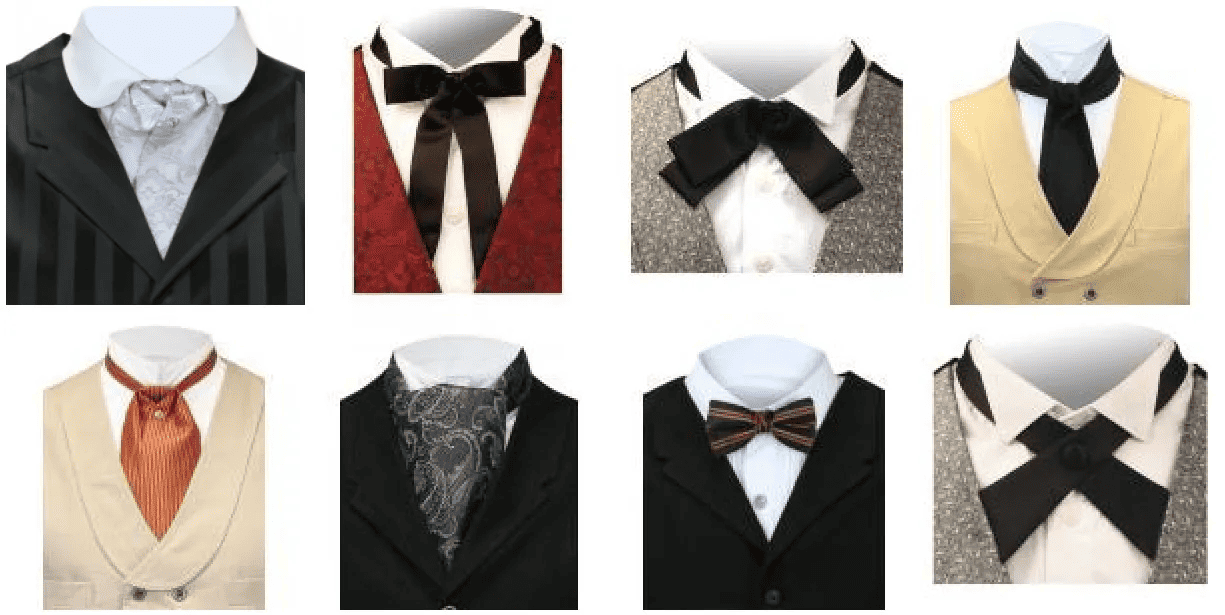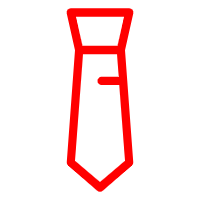
What Are Different Ties Called?
The Importance of Ties in Fashion
Ties have been an essential accessory in men's fashion for centuries. Not only do they add a touch of class to any outfit, but they also allow individuals to express their style and personality.
From job interviews to formal events, ties have become a staple in both professional and social settings. Whether you prefer the classic look of a standard tie or the bold statement of a bow tie, there is no denying the importance that ties hold in the world of fashion.
Types of Ties and Their Names
When it comes to ties, there are various types available in the market today. Each type has its unique style and name.
The most common type is the standard tie, which comes in different sizes and styles such as four-in-hand, Windsor, and Half-Windsor. Bow ties are another popular option known for their distinctive shape and knotting technique.
They can come as self-tie or pre-tied bow ties or butterfly bow ties. Ascot ties are associated with formality; there are day cravat or formal ascot styles available for different occasions depending on how one would like to wear them.
Bolo ties have western roots with traditional bolo tie options compared to string bolo that adds uniqueness to the accessory collection. It's worth noting that neckties from around the world have become increasingly popular too in recent years through globalization efforts.
Various cultures use neckties as an accessory hence creating different forms such as cravats from France or kipper from UK besides others that will be discussed later on. Now that we've covered some basics let's dive into each type category deeper- starting with standard ties!
Standard Ties
Ties are a staple in men's fashion and have been for centuries. The standard tie is perhaps the most common type of tie you will see people wearing. A standard tie is typically made of silk or polyester and is worn with a dress shirt to add sophistication to any formal or semi-formal outfit.
Description of Standard Ties and Their Common Uses
The standard tie is usually around 57 inches long, 3-4 inches wide, and has a pointed end. Standard ties can be worn in various settings such as business meetings, weddings, and even casual events such as dinners or dates. It is important to choose the right color and pattern that matches your outfit for the occasion at hand.
Different Types of Standard Ties: Four-in-hand Tie
The four-in-hand tie is perhaps the most popular type of standard tie. This type of tie gets its name from a style used by coachmen who would knot their ties using four turns before tucking them into their jackets while driving their carriages. Today, it remains popular because it's easy to wear and goes well with most outfits.
Different Types of Standard Ties: Windsor Tie
The Windsor knot takes its name from the Duke of Windsor who was famous for his impeccable fashion sense in the early 20th century. It's a wider knot that looks best when worn with spread collar shirts because it fills up the space between the collar points nicely. This type of knot requires more fabric than other knots, so use caution when selecting your necktie.
Different Types of Standard Ties: Half-Windsor Tie
The half-Windsor knot falls somewhere between the four-in-hand knot and full Windsor Knot in terms of size and shape. It is a medium-sized knot that looks best with classic-style dress shirts that have a regular spread collar. This knot is also ideal for those who want to look polished without being too flashy.
Overall, standard ties are an essential item in every man's wardrobe. From job interviews, weddings, and business meetings to dinner dates and casual outings, the right tie can elevate your look and make you feel confident.
Bow Ties: A Classic Accessory for the Fashion-Forward
Bow ties have been a fashion staple for decades, adding a touch of sophistication and style to any outfit. These unique accessories are known for their distinctive shape, which sets them apart from traditional neckties. Whether you're looking to dress up or add some flair to your everyday look, a bow tie is the perfect choice.
Self-Tie Bow Tie: Customize Your Look
The self-tie bow tie is the classic style that has been around for centuries. It's also known as the "freestyle" bow tie because you have complete control over how it looks.
The self-tie bow tie comes in various shapes and sizes, so you can choose one that complements your face and body type. For the perfect knot, practice makes perfect, but once you master it, it's a skill that will never leave you.
Pre-Tied Bow Tie: Easy and Convenient
For those who don't have time to learn how to tie a self-tie bow tie or just prefer an easy-to-wear option, there's the pre-tied bow tie. This type of bow tie comes with a knot already tied and just needs to be fastened around the neck. Pre-tied bow ties are great if you're in a rush or if tying a self-tie is too difficult.
Butterfly Bow Tie: Make a Statement
The butterfly bow tie is one of the most popular styles of bows because its larger size makes it more noticeable than other types of bows. This style consists of two large wings that give off an elegant look while making an eye-catching statement piece for any outfit. When it comes to choosing between different types of bow ties, you have plenty of options to choose from.
Whether you prefer a self-tie or pre-tied bow tie, or if you want to make a statement with the butterfly bow tie, there's a style that will suit your taste and needs. No matter what type of bow tie you choose, it's sure to add some pizzazz to your wardrobe and make you stand out in any crowd.
Description of Ascot Ties and Their Formal Appearance
Ascot ties are known for their formal appearance. They are perfect for dressing up any outfit or for special occasions such as weddings or black-tie events.
They are similar to neckties but have a wider, flat bottom that is usually tucked into a vest or shirt. The ascot tie is named after the Ascot Racecourse in England, where it was first worn in the late 19th century.
Different Types of Ascot Ties
There are two main types of ascot ties: the day cravat and the formal ascot.
Day Cravat
The day cravat is a less formal version of the traditional ascot tie. It is made from lightweight materials such as cotton or silk and comes in a variety of colors and patterns. It can be paired with casual clothing such as a button-down shirt and blazer, or even with jeans and a sweater.
Formal Ascot
The formal ascot is more structured and elegant than its casual counterpart. It is made from silk or satin and usually comes in solid colors like black, white, or navy blue.
It's typically worn with tuxedos or other formalwear and gives off an air of sophistication. Whether you're looking for a casual yet stylish way to dress up your outfit or want to add an extra touch of elegance to your formal attire, an ascot tie is definitely worth considering!
Bolo Ties
The Spirit of the West
If you've ever seen a Western movie, you've probably noticed the iconic bolo tie. Known for its braided leather cord and decorative clasp, this type of tie is steeped in the history and culture of the American West.
Originally called a "bootlace tie," it's said that cowboys would wear them to keep their collars from flapping while riding horses. There are two main types of bolo ties: traditional and string.
The traditional bolo tie has a metal or stone clasp that slides up and down on a braided leather cord. The string bolo tie, on the other hand, has no clasp and consists simply of a braided leather cord with tassels at each end.
A Bold Fashion Statement
Today, bolo ties are worn not only as an homage to Western heritage but also as a bold fashion statement. They come in a variety of styles and materials, from simple leather cords with silver clasps to elaborate designs featuring gemstones or intricate metalwork. Bolo ties are versatile enough to be worn with both casual outfits and more formal attire.
They add an interesting touch to button-up shirts or blouses and can even be paired with suits for an unexpected twist on traditional menswear. No matter how you choose to wear them, bolo ties are undoubtedly unique accessories that add personality and character to any outfit.
Neckties from Around the World
While neckties may be a staple item in many Western countries, they have a long history and varied styles across the globe. Here are just a few examples of neckties from different cultures:
Cravat (France)
The cravat is considered to be the precursor to modern-day neckties. Originating in France in the 17th century, it was worn by Croatian mercenaries who worked for Louis XIII. The style quickly caught on among French aristocrats and evolved into various styles over time.
Kipper Tie (UK)
The kipper tie is a bold and wide necktie that was popular in the UK during the 1960s and 70s. It earned its name due to its resemblance to a kipper fish, which is often served for breakfast in England.
Conclusion
From standard ties to bow ties, ascot ties, bolo ties, and beyond – there truly is no shortage of variety when it comes to this quintessential accessory. Regardless of where they originated or what style they take on, one thing remains constant: ties have the power to elevate any outfit into something special and noteworthy. So next time you're getting dressed up for an event or just want to add some extra flair to your everyday look, consider experimenting with different types of ties – you never know what new fashion statement you might make!
Post time: Jun-12-2023



















